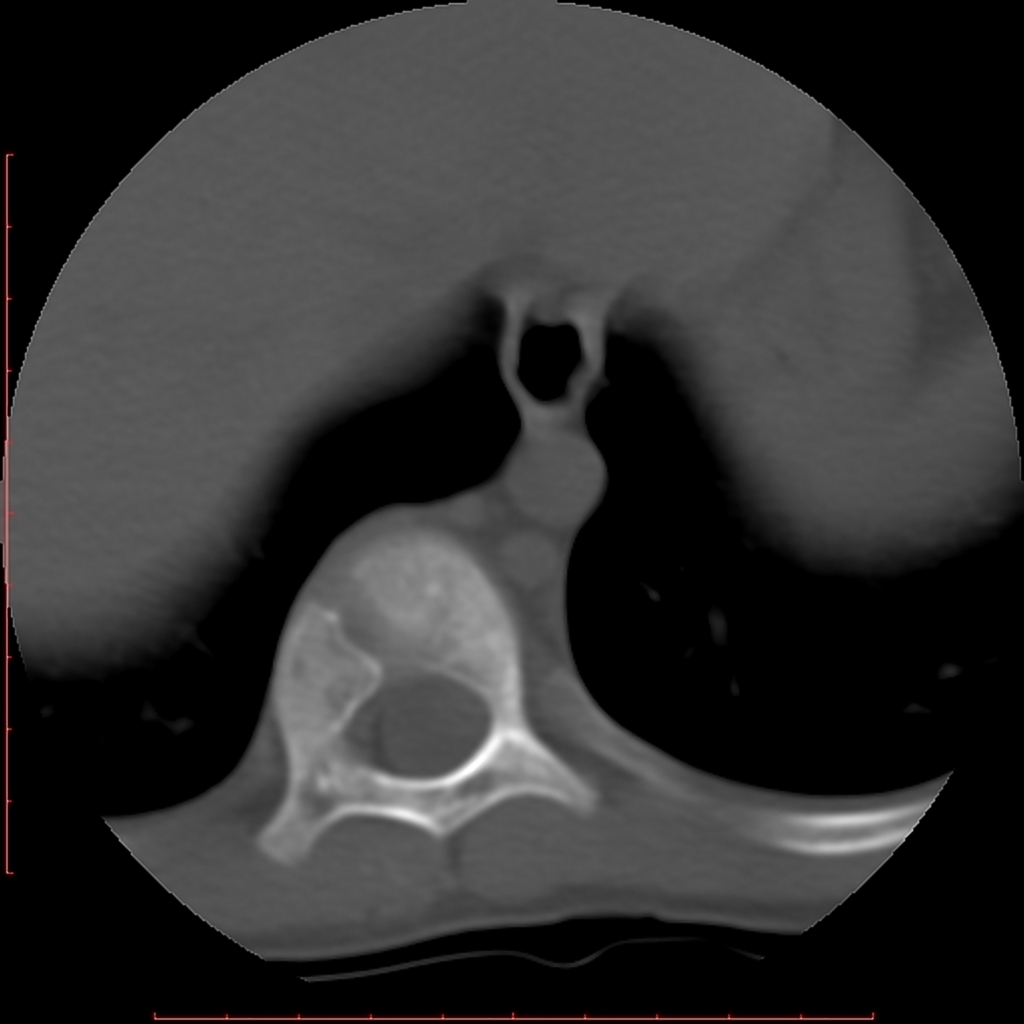Scoliosis classification: Difference between revisions
Jump to navigation
Jump to search
No edit summary |
|||
| Line 7: | Line 7: | ||
=== Congenital Scoliosis === | === Congenital Scoliosis === | ||
[[File:Hemivertebra-with-congenital-scoliosis.jpg|thumb|Right supernumerary D10/D11 hemivertebra is noted associated with mild right dorsal scoliosis as well as mild focal kyphotic deformity. [https://radiopaedia.org/cases/hemivertebra-with-congenital-scoliosis-3Source: Case courtesy of Dr Mohammad A. ElBeialy, Radiopaedia.org, rID: 41542]]] | {| align="right" | ||
| | |||
[[File:Hemivertebra-with-congenital-scoliosis.jpg|100px|thumb|Right supernumerary D10/D11 hemivertebra is noted associated with mild right dorsal scoliosis as well as mild focal kyphotic deformity. [https://radiopaedia.org/cases/hemivertebra-with-congenital-scoliosis-3Source: Case courtesy of Dr Mohammad A. ElBeialy, Radiopaedia.org, rID: 41542]]] | |||
|} | |||
* Congenital scoliosis is subdivided based on radiological finding, combined structural component involved and 3-D CT.<ref>{{cite journal |last1=Winter |first1=RB |last2=Moe |first2=JH |date=1960,Jan 01 |title=Congenital Scoliosis A Study of 234 Patients Treated and Untreated Part I: Natural History |url= |journal=J Bone Joint Surg Am. |volume=50 |issue=1 |page=1-15 |doi= |pmc= |pmid= |access-date= | name-list-format=vanc }}</ref><ref>{{cite journal |last1=Imagama |first1=S |last2=Kawakami |first2=N |date=2005 |title=Spatial relationships between a deformed vertebra and an adjacent vertebra in congenial scoliosis-failure of formation. |url= |journal=J Jpn Scoliosis Soc. |volume=20 |issue= |pages=20-25 |doi= |pmc= |pmid= |access-date= | name-list-format=vanc }}</ref> | * Congenital scoliosis is subdivided based on radiological finding, combined structural component involved and 3-D CT.<ref>{{cite journal |last1=Winter |first1=RB |last2=Moe |first2=JH |date=1960,Jan 01 |title=Congenital Scoliosis A Study of 234 Patients Treated and Untreated Part I: Natural History |url= |journal=J Bone Joint Surg Am. |volume=50 |issue=1 |page=1-15 |doi= |pmc= |pmid= |access-date= | name-list-format=vanc }}</ref><ref>{{cite journal |last1=Imagama |first1=S |last2=Kawakami |first2=N |date=2005 |title=Spatial relationships between a deformed vertebra and an adjacent vertebra in congenial scoliosis-failure of formation. |url= |journal=J Jpn Scoliosis Soc. |volume=20 |issue= |pages=20-25 |doi= |pmc= |pmid= |access-date= | name-list-format=vanc }}</ref> | ||
Revision as of 21:52, 5 December 2018
|
Scoliosis Microchapters |
|
Diagnosis |
|---|
|
Treatment |
|
Case Studies |
|
Scoliosis classification On the Web |
|
American Roentgen Ray Society Images of Scoliosis classification |
|
Risk calculators and risk factors for Scoliosis classification |
Editor-In-Chief: C. Michael Gibson, M.S., M.D. [1]; Associate Editor(s)-in-Chief: Rohan A. Bhimani, M.B.B.S., D.N.B., M.Ch.[2]
Classification
Scoliosis can be classified into congenital scoliosis (due to failure of vertebral formation or segmentation of affected vertebrae), idiopathic scoliosis(when the cause is not known) or neuromuscular scoliosis (due to loss of muscle strength or voluntary muscle control).
Congenital Scoliosis
 |
- Congenital scoliosis is subdivided based on radiological finding, combined structural component involved and 3-D CT.[1][2]
| Complete failure - hemivertebra, butterfly vertebra | |
| Failure of formation | Partial failure - wedged vertebra |
| Unilateral failure - longitudinal failure | |
| Failure of segmentation | Bilateral failure - block vertebra |
| Miscellaneous | Formation and segmentation mixed failure |
| Anterior component | Posterior component |
|---|---|
| Hemivertebra (hemipedicle) | Fully segmented hemilamina |
| Semisegmented hemilamina | |
| Spina bifida | |
| Bilamina (complete or incomplete) | |
| Butterfly lamina (bipedicle) | Wedged lamina |
| Spina bifida | |
| Lateral wedged vertebra (bipedicle) | Wedged Lamina |
| Type 1 | Solitary simple congenital malformation (unison)
|
| Type 2 | Multiple simple anomalies (unison)
|
| Type 3 | Complex anomalies (discordant)
|
| Type 4 | Segmentation failure only |
Idiopathic Scoliosis
- Idiopathic scoliosis may be further classified into three types based on age of onset.[3]
- Infantile idipathic scoliosis (birth to 3 years)
- Juvenile idiopathic scoliosis (4 to 9 years)
- Adolescent idiopathic scoliosis (10 to 20 years)
Neuromuscular Scoliosis
- Neuromuscular scoliosis can be further subdivided based on the classification of scoliosis research society.[4]
- Primary neuropathies
- Upper motor neuron neuropathies
- Cerebral palsy
- Spinocerebellar degeneration
- Syringomyelia
- Spinal cord tumor
- Spinal cord trauma
- Lower motor neuron neuropathies
- Poliomyelitis
- Other viral myelitides
- Traumatic
- Charcot-Marie-Tooth disease
- Spinal muscular atrophy
- Werdnig-Hoffmann disease (SMA type 1)
- Kugelberg-Welander disease (SMA type 2)
- Dysautonomia
- Combined upper and lower pathologies
- Amyotrophic lateral sclerosis
- Myelomeningocele
- Tether cord
- Primary myopathies
- Muscular dystrophy
- Duchenne muscular dystrophy
- Limb-girdle dystrophy
- Facioscapulohumeral dystrophy
- Arthrogryposis
- Congenital hypotonia
- Myotonia dystrophica
- Muscular dystrophy
References
- ↑ Winter RB, Moe JH (1960,Jan 01). "Congenital Scoliosis A Study of 234 Patients Treated and Untreated Part I: Natural History". J Bone Joint Surg Am. 50 (1): 1-15. Check date values in:
|date=(help) - ↑ Imagama S, Kawakami N (2005). "Spatial relationships between a deformed vertebra and an adjacent vertebra in congenial scoliosis-failure of formation". J Jpn Scoliosis Soc. 20: 20–25.
- ↑ Azar, F., Canale, S., Beaty, J. & Campbell, W. (2017). Campbell's operative orthopaedics. Philadelphia, PA: Elsevier. Page: 1898-2028.
- ↑ McCarthy, Richard E. (1999). "MANAGEMENT OF NEUROMUSCULAR SCOLIOSIS". Orthopedic Clinics of North America. 30 (3): 435–449. doi:10.1016/S0030-5898(05)70096-1. ISSN 0030-5898.